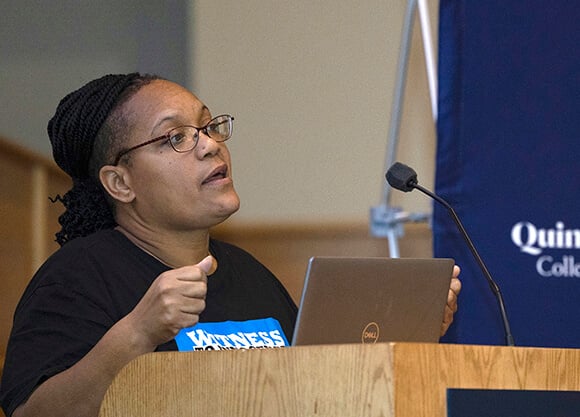
First woman exonerated from death row shares aching story of victory and loss
February 28, 2023

February 28, 2023

Walter D. Butler was 4 months old in this particular photo, creased by thousands of heartbroken touches. Five months later, on April 11, 1989, little Walter was dead. And his mother was bound for Mississippi’s death row.
“I sat in the county jail a whole year before I even went to trial,” Butler-Smith told a full house last semester at the Mount Carmel Auditorium. “I saw my attorney two days before trial. Two days. The only preparation he gave me was to sit and look at the jury. That’s all I was told to do.
“So when I got to the courtroom, I was sitting there looking at the jury, and the jury didn’t look like me,” she added. “Nobody looked like me. And I knew — just by looking at that — that my life was over.”
Butler-Smith’s talk at Quinnipiac coincided with this year’s creation of the Department of Justice and Law in the College of Arts and Sciences. The new department brings together legal studies and criminal justice majors so students can better understand the U.S. justice system in historical and contemporary contexts.
In all, Butler-Smith spent 6 1/2 years in prison, including nearly three years on death row. All the while, little Walter’s memory kept Butler-Smith going.
It kept her going while she shuffled down a cold hallway in ankle irons. It kept her going while rats darted in and out of her bathroom-sized prison cell. It kept her going when food trays came with ants and other bugs.
But most of all, it kept Butler-Smith going until her conviction was overturned on Aug. 25, 1992. Three years later, she became the first woman exonerated from death row.
Alan Bruce, professor of criminal justice and director of criminal justice, cited the thousands of exonerations, including death row exonerations, since 1989, according to the National Registry of Exonerations. As of February, that figure was 3,387 exonerations.
However, he suspects this data is significantly underreported. Butler-Smith’s case is one of the anomalies. “This number is the tip of the iceberg as wrongful convictions are rarely discovered,” Bruce said.

In Butler-Smith’s case, a spring night in eastern Mississippi changed everything.
Butler-Smith was a 17-year-old single mother of two the night Walter stopped breathing. She carried him in her arms as she banged on door after door in the apartment complex where she lived in Columbus, Mississippi, a small river town of about 23,000 people.
Finally, one woman answered and performed CPR on Walter while Butler-Smith ran outside to get a ride to the hospital. It wasn’t until later that she learned the woman performed adult CPR on Walter, not CPR for infants.
Unknowingly, Butler-Smith repeated the mistake on the way to the hospital. But it was already too late. When she arrived at the emergency room, hospital staff whisked Walter away, but they were unable to resuscitate him.
Butler-Smith never saw her beautiful little boy again, the one with the enchanting brown eyes and a car on his white overalls.
The next morning, local police brought her in for questioning. She was all alone — no parents, no attorney, no hope. “They took me to this little room, two guys, and before I could sit down in the chair, they started in on me,” Butler-Smith said.
The accusations were relentless: “You stomped your baby! You beat him! This is what you did! You know you did!”
Butler-Smith was eventually charged with capital murder and child abuse. As she later learned, the child abuse charge was based on a law that didn’t go into effect until 23 days after she had been incarcerated. Not that it would’ve changed anything.
After a trial where her appointed defense team included a divorce attorney rather than a criminal defense attorney, Butler-Smith was sentenced to death on March 13, 1990. Her execution was set for July 2, 1990. She was just 19 years old.
Butler-Smith spent the next 33 months on death row. “You can’t go in there weak because you won’t survive,” she said. “You have to be strong. I had to fight almost every day in jail because they would call me child killer, murderer, all this kind of stuff. Nobody believes you. Nobody.”
Well, almost nobody.
Clive Stafford Smith, a British-born attorney with a law degree from Columbia University and a successful record of defending death row inmates, believed her. So did Rob McDuff, who joined Stafford Smith on the case. Together, they went to work and dismantled the prosecution’s case with surgical-like precision.
After getting Walter’s hospital records, they discovered he suffered from polycystic kidney disease, a genetic disorder that causes cysts to form in the kidneys and could lead to kidney failure. The disease may also affect the liver, heart and other organs.
This medical evidence, a plausible contributor to Walter’s death, wasn’t introduced in the first trial. Likewise, her lawyers in the first trial didn’t call a single witness.
On appeal, the Mississippi Supreme Court overturned Butler-Smith’s conviction and sentence. The court also ruled that Butler-Smith was a victim of false or misleading forensic evidence as well as prosecutorial misconduct by Lowndes County District Attorney Forrest Allgood.
During Butler-Smith’s second trial, Stafford Smith and McDuff interviewed neighbors at the apartment complex who confirmed her story. A medical expert also testified that performing adult CPR on Walter rather than infant CPR could have caused the injuries that led to his death.
The jury deliberated for less than an hour. Sabrina Butler-Smith was a free woman. Or was she?
Butler-Smith was exonerated a week before Christmas on Dec. 17, 1995. The chains were gone, but the shackles of wrongful imprisonment, solitary confinement and the loss of Walter will stay with her forever.
“People say, ‘Well, the system worked for you.’ No, the system didn’t work,” Butler-Smith said. “My case was done despite the system. That’s why I’m here because if it had been done the way it should’ve been, I should’ve never had to go through what I went through.”
Get the latest news and events sent right to your email by subscribing to Quinnipiac Today
Subscribe